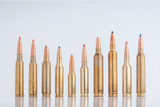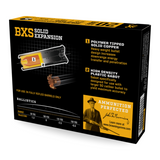Insiders Secrets to Shooting Well
Insider's Secrets to Shooting Well...
Barrel Time, Lock Time, Trajectory, and Practical Accuracy
| written 2000 copyright EABCO, by Eben Brown Everyone knows that being able to hit what you're aiming at with any firearm takes skill, a good gun, and quality ammunition. But there's a lot more going on beneath the surface. If you know and understand these aspects of Ballistic Science, you should be able to shoot better. Barrel Time and Lock Time - You may have heard these terms before. The reason they're important is that a gun and/or a marksman can move enough to throw the aim off target by the time the bullet actually leaves the barrel. The faster the barrel and lock time, the less affect movement will have on aiming point. It's worth considering when you're shopping for a gun, barrel length, and cartridge. Two things affect barrel time: Barrel Length and Velocity. Sometimes rifle shooters are shocked at how accurate single shot pistols can be. One of the reasons is that the single shot pistol's shorter barrel cuts the barrel time tremendously. Consider a 10¾" BF Silhouette Pistol in 7mm US. A 140 gr bullet traveling 1900 fps takes just .47 milliseconds to travel the length of the barrel. Now consider a 26" rifle in 7mm Remington Magnum. A 140 gr bullet traveling 3100 fps takes .70 milliseconds to travel the length of the barrel! The 7 Mag has a slower barrel time than the 7US... Shocking, isn't it? Well, the lesson to be taken from this comparison is that an extra few hundred feet per second gained by a longer barrel may actually be a handicap when the increase in barrel time affects your ability to shoot accurately. What's more, a slightly slower cartridge in a well balanced barrel length might be more natural pointing while giving the same or comparable barrel time to a long barreled magnum. Lock time is affected by the quality of your trigger system and the complexity and travel of your firing mechanism. A bad trigger makes it difficult for the shooter to anticipate sear release. Drag, creep, roughness, etc. The shooters trigger control affects his timing. Beyond this, the complexity of the trigger affects the lock speed. For example, to achieve light trigger pulls, some trigger systems have compound linkages that might slow the sear release. A T/C Contender actually has two sear releases. The first is directly released by the trigger. That sear swings up and actuates a sear connected to the hammer. This lets the hammer swing forward. A dramatic example of slow lock time is the old Flintlock firing mechanism. The trigger releases the hammer which strikes the frizzen and a spark falls into the flash pan. The flash powder ignites in a Phoosh and the flame travels from the pan into the barrel to ignite the main powder charge. Try and keep holding the sights on target while all of that is happening! Thankfully, modern firearms locktimes are much faster. On hammer based actions, look for simplicity in trigger mechanisms and short hammer travel distances to get the fastest lock time. On in-line actions such as bolt actions, look again for fast trigger systems and short traveling firing pins. The long firing pins in bolt guns have a lot of mass to accelerate but in recent years, the introduction of lightweight titanium firing pins (available as an aftermarket kit) has helped. So What's the Point? Everyone has been taught not to jerk the trigger, not to flinch, and not to breath when aiming and firing a shot. Probably airgun shooters and shotgunners are more keenly aware of "following through"... keeping the aim on target all the way through and beyond the trigger squeeze. All of these are the things you do to minimize the effects of barrel time and lock time. You should also take barrel time and lock time into account when deciding which gun to buy, which cartridge is suitable, and and how long of a barrel would be best. Trajectory - The flight path of a bullet from gun muzzle to target. Like the path of a spiraling football, all bullets travel from gun barrel to target in an arch shaped path. You'll often hear the term "Flat Shooting Cartridge", but physics and gravity dictate that all bullets will travel in an arch-shaped trajectory. It is more accurate to refer to trajectories as being either more, or less flat than one another by comparison. Besides the "Flat Shooting" myth, there are other common misunderstood concepts. For example, I'm often asked about a particular cartridge, "How much does it drop at 200 yards?" The answer is ZERO... if I'm sighted in for 200 yards! The bullet drop at any range depends on what range the gun is sighted in for. Look at it this way: The trajectory of a bullet carries it first upward and then downward (in an arch) until it hits the target. Beyond the range of the target, the bullet has already begun its downward plunge and continues to drop at an accelerating rate. And, the steeper this after-target angle of descent becomes the more difficult it is to estimate "Hold-over". In my opinion, figuring to aim high at ranges beyond your sight zero is the wrong approach. Here's is my reasoning: The angles of ascent and descent are much shallower and more predictable in the portion of a trajectory that's between the gun muzzle and the zeroed sight distance. So, the better approach is to sight the gun in for the maximum distance that's practical for one sight setting and estimate how much to hold "Under" at shots taken under that distance. This way, you don't have to be especially good at judging distances... if in doubt, just aim a little low. Maybe its time to look at some numbers... Here are four cartridges with 200 yard zeroed sight trajectories taken from the ballistic charts in the Hornady Reloading Manuals:  For hunting deer sized game, you can see how the marksman can really count on his aiming point when he knows the trajectory between muzzle and sight-in distance. With the three rifles, he can aim center-of-body all the way out to 200 yards and make a good shot. Even with the pistol he can aim a little low with confidence for a 100 yard shot. As a general rule of thumb, any spitzer bullet traveling 1800 fps or faster will shoot flat enough to zero sights for 200 yards and hit deer reliably at all ranges under 200. Now let's take a look at 300 yard zeroed sight trajectories:  Still thinking in terms of deer sized game, you can see how the trajectory between muzzle and zeroed-sight point can be predictable and useful for accurate shooting. With the three rifles, the hunter need only aim a little low center-of-body to make a good shot all the way out to 300 yards (Take out a ruler and see what 3-8 inches of hold-under looks like compared to the chest area of a deer). With the pistol, the trajectory is not flat enough to have one sight setting for hunting at ranges out to 300 yards. Now let's take a look at 400 yard zeroed sight trajectories:  Again, in terms of hunting dear sized game with one sight setting, you can see now that neither the 6.5BRM nor the .308 Win. shoot flat enough to hunt with one sight setting out to 400 yards. With the 300 Win Mag, a skilled marksman might be able to hold variously low at various ranges under 400 yards, but it is probably best to figure 400 yards as too far even for the 300 Win Mag to hunt and hit reliably with one sight setting.
|
Recent Posts
-
6.5mm Cartridge Comparison
6.5mm Cartridge Comparison (Pictorial Overview) A Quick Look at Popular 6.5mm Rifle Cartridges Vis …Aug 11th 2025 -
Rethinking Shotgun Slug Accuracy: Why Slower Might Be Better
Last year the Browning slugs I ended up using were a departure from conventional thinking but they …Jun 12th 2025 -
The Timeless Appeal of the .308 Winchester: Why This Cartridge Endures
The .308 Winchester, introduced in 1952, has become one of the most enduring cartridges in firearms …Jul 11th 2024


